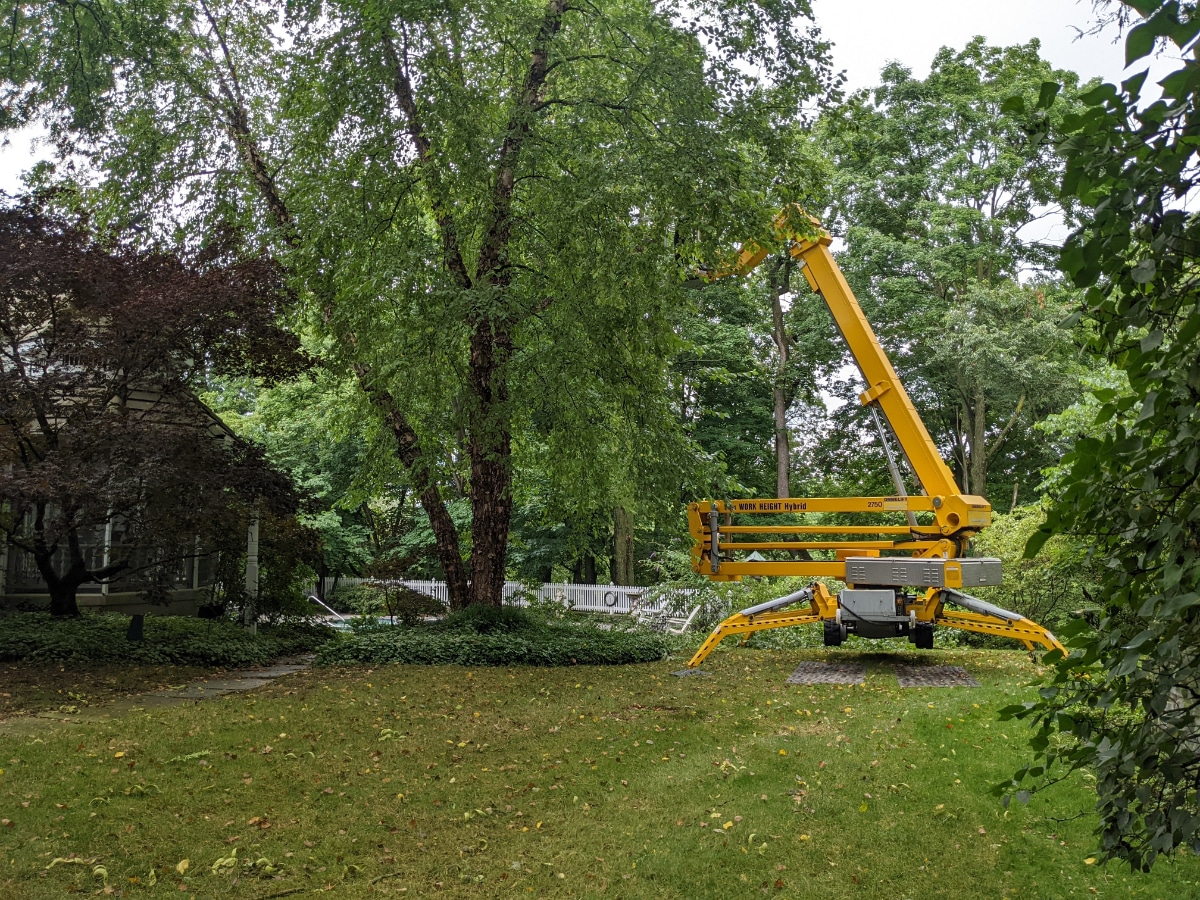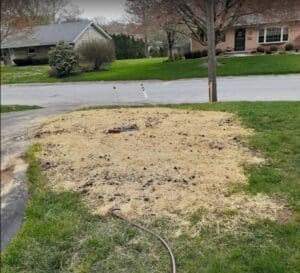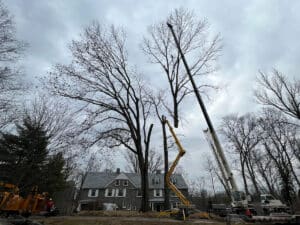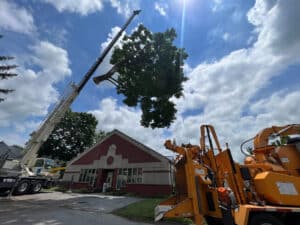This guide covers the best practices and timing for trimming (the technical term is pruning) various types of trees in Pennsylvania, and explains the benefits of hiring a professional Pennsylvania arborist to handle tree trimming.
Key Takeaways
- Generally speaking, the best time for pruning trees in Pennsylvania is during their dormant season, ideally between late January and early March. But large trees can be trimmed at any point in the year.
- Different tree types require specific pruning techniques and timings
- Professional tree trimming improves tree health, reduces safety hazards, and can increase property value.
Optimal Seasons for Pruning Trees in Pennsylvania
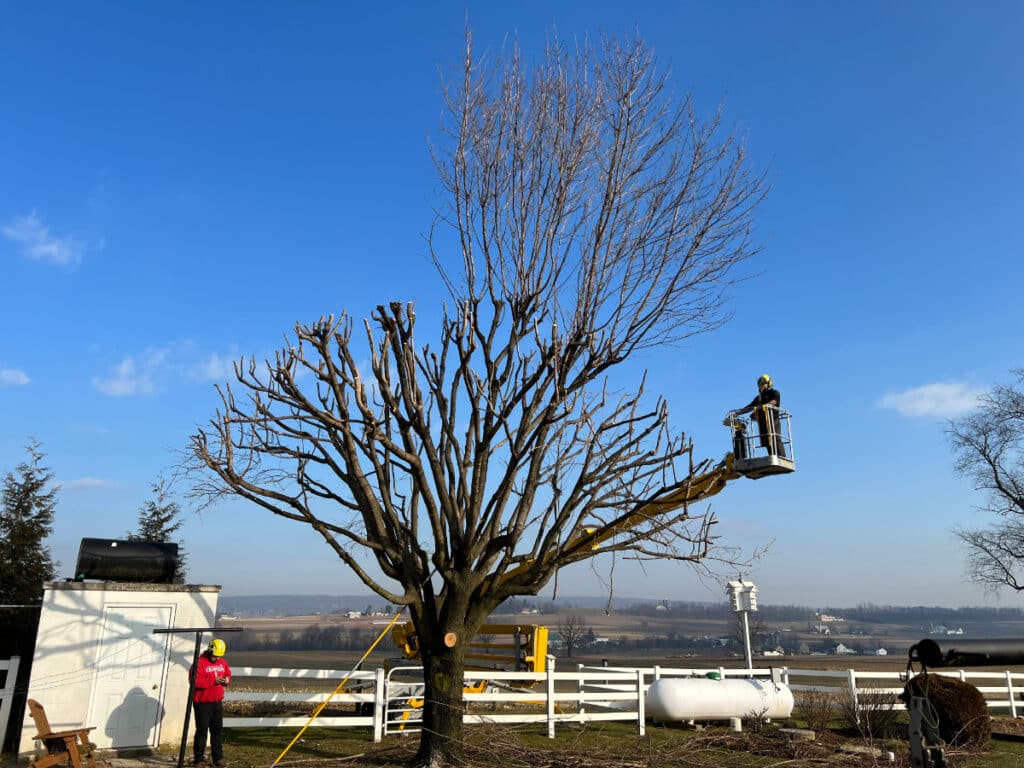
When it comes to pruning trees in Pennsylvania, timing is everything. The best time to prune deciduous trees is in the late fall, winter, or early spring. Among these, winter is considered the most optimal time. Pruning during the dormant season, ideally between late January and early March, minimizes disease spread and promotes faster healing.
Plus, winter pruning has the added benefit of causing less damage to your yard since the ground is firmer. Adhering to these seasonal guidelines helps ensure your trees get the care they need, keeping trees healthy and robust throughout the year.
Pruning Timings and Techniques for Pennsylvania Trees
Pruning trees isn’t a one-size-fits-all task. Different types of trees require different pruning techniques and timings to thrive. Knowing how and when to prune can make a significant difference in the health and appearance of your trees. Hence, hiring an experienced local tree service to trim your Pennsylvania trees becomes essential.
Now, we’ll explore the specifics for various tree types, including deciduous, evergreen, flowering, and fruit trees. Each has its unique requirements, and understanding these can help you make the best decisions for your landscape.
Deciduous Trees
Deciduous trees, such as Oak, Maple, Beech, and Poplar, are common in Pennsylvania. These trees lose their leaves in the winter, making late fall through early spring the best time to prune them. Pruning during their dormant season, before new growth starts, helps promote healthy growth and shape. When pruning, special attention should be given to the tree’s crown to ensure that leaves are not overly exposed to sunlight, which can cause leaf burn.
When pruning deciduous trees, arborists focus on removing dead or diseased branches and making cuts that enhance the tree’s natural shape. This practice helps maintain the tree’s health and encourages new growth.
Evergreen Trees
Evergreen trees, including Pine, Spruce, Fir, and the Eastern Hemlock, keep their leaves year-round. This means they can be pruned at any time of the year. However, it’s best to avoid pruning during extreme weather conditions like heatwaves or freezing temperatures.
For evergreen trees, effective trimming involves removing any dead or damaged branches while avoiding excessive pruning to prevent stress on the tree. Regular, light pruning helps maintain their shape and health, ensuring they continue to be a vibrant addition to your landscape.
Flowering Trees
Flowering trees, such as Dogwood, Cherry, Crabapple, and Eastern Redbud, are prized for their beautiful blooms. To avoid cutting off next season’s flowers, it’s best to prune flowering trees immediately after they finish flowering.
Pruning flowering trees involves removing dead or diseased branches and shaping the tree to enhance its natural beauty. This practice ensures the tree remains healthy and continues to produce stunning blooms each year.
Fruit Trees
Fruit trees, including Dogwood, Cherry, Crabapple, and Eastern Redbud, require special attention to ensure they remain healthy and productive. The best time for pruning fruit trees is during late winter or early spring while they are still dormant.
Pruning fruit tree involves removing dead wood and strategically shaping the tree to encourage fruit production. This helps maintain the tree’s health and ensures a bountiful harvest.
Benefits of Professional Tree Trimming
While it’s possible to prune trees yourself, hiring a professional tree service like Sunny Slope offers numerous benefits. Professional arborists understand the importance of properly managing the tree’s crown to prevent issues like leaf burn and ensure overall tree health. Professional arborists have the expertise to prune trees properly, ensuring their health and safety. This not only enhances the appearance of your property but also prevents potential issues down the line.
Let’s explore the specific benefits of professional tree trimming, from improved tree health to increased property value.
Improved Tree Health
A professional arborist knows how to prune trees to keep them healthy and safe. They can identify potential issues and take corrective steps to maintain the tree’s health and stability for many years to come. Proper pruning techniques, such as removing dead or diseased branches, can significantly improve the overall health of the tree.
Regular pruning ensures the longevity and vitality of your mature trees, enhancing the appearance and health of your landscape.
Increased Safety
Tree branches that are left unpruned can easily cause property damage and injuries. Unhealthy limbs, including broken branches, are prone to disease or death, making them hazardous.
Professional pruning addresses dangerous branches before they become problematic.
Decreased Pest Risk
Regular pruning prevents the spread of pests and diseases by removing unhealthy plant parts. Dead branches can create entry points for pests and diseases, compromising tree health.
Improved Appearance
Beautifully pruned trees can enhance any outdoor space and add to the overall aesthetic of the property. Properly managing the tree’s crown not only enhances its appearance but also ensures that the tree remains healthy and vibrant. Proper pruning techniques, such as crown reduction, can shape the tree and encourage new growth, ultimately revealing the tree’s crown.
Increased Property Value
Well-maintained trees can significantly boost property value and make it more appealing to potential buyers. Think about those drooping, split trees you’ve seen in someone’s yard, with low-hanging branches and scraggly leaves—definitely not a good look.
Long-Term Savings
Sunny Slope Tree Service’s expert tree pruning and trimming services ensure that trees remain healthy, reducing the need for more drastic measures like removing the entire tree in the future.
This can save time and money in the long run.
Sunny Slope Tree Service: Your Choice for Professional Tree Trimming in Southeastern Pennsylvania

When you’re ready to prune your trees, Sunny Slope Tree Service is your experienced Southeastern and Central Pennsylvania tree service provider. Since 1996, we’ve been helping homeowners and property owners remove and trim trees safely across Lancaster, Chester, and surrounding counties.
Sunny Slope Tree Service helps you avoid potential issues with thorough tree evaluations, expert pruning by skilled arborists, and tree trimming that enhances, preserves, and beautifies your property for the long term. Additionally, we offer tree removal, stump removal, and brush clearing services.
Call today for a free consultation and estimate on-the-spot.
Summary
Pruning is essential for the health and beauty of your trees. By understanding the optimal seasons and techniques for pruning different types of trees in Pennsylvania, you can ensure that your landscape remains vibrant and healthy. Hiring a professional tree service like Sunny Slope offers numerous benefits, from improved tree health to increased property value.
Take action today to keep your trees in top shape. Whether you do it yourself or hire professionals, proper pruning is key to a beautiful and safe property.

